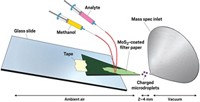Advertisement
Grab your lab coat. Let's get started
Welcome!
Welcome!
Create an account below to get 6 C&EN articles per month, receive newsletters and more - all free.
It seems this is your first time logging in online. Please enter the following information to continue.
As an ACS member you automatically get access to this site. All we need is few more details to create your reading experience.
Not you? Sign in with a different account.
Not you? Sign in with a different account.
ERROR 1
ERROR 1
ERROR 2
ERROR 2
ERROR 2
ERROR 2
ERROR 2
Password and Confirm password must match.
If you have an ACS member number, please enter it here so we can link this account to your membership. (optional)
ERROR 2
ACS values your privacy. By submitting your information, you are gaining access to C&EN and subscribing to our weekly newsletter. We use the information you provide to make your reading experience better, and we will never sell your data to third party members.
Analytical Chemistry
Aptamer-Graphene Combos Pull Analytic Double Duty
Small-molecule-binding nucleic acids conjugated to graphene oxide improve detection of cocaine and other analytes
by Celia Henry Arnaud
December 6, 2010
| A version of this story appeared in
Volume 88, Issue 49
Small-molecule-binding nucleic acids conjugated to graphene oxide improve extraction and ionization of analytes from biological samples, an international research team has discovered (J. Am. Chem. Soc., DOI: 10.1021/ja109042w). Weihong Tan of the University of Florida and coworkers at Stanford University and China’s Hunan University attach aptamers—single-stranded oligonucleotides that bind target molecules with high affinity—to the surface of graphene oxide via a flexible poly(ethylene glycol) linker. The linker stabilizes the construct in biological fluids and allows the aptamers to fold into their three-dimensional conformations. The researchers used graphene oxide modified with a cocaine-binding aptamer to extract cocaine from spiked plasma samples and then analyzed the drug by mass spectrometry directly from the graphene oxide surface. With unmodified graphene oxide, Tan and colleagues observed a signal-to-noise (S/N) ratio of about 15 in the mass analysis. The aptamer-modified graphene oxide efficiently captured the cocaine and boosted the S/N ratio to an average of 52. The researchers achieved similar improvements with graphene oxide attached to an adenosine-binding aptamer.




Join the conversation
Contact the reporter
Submit a Letter to the Editor for publication
Engage with us on Twitter